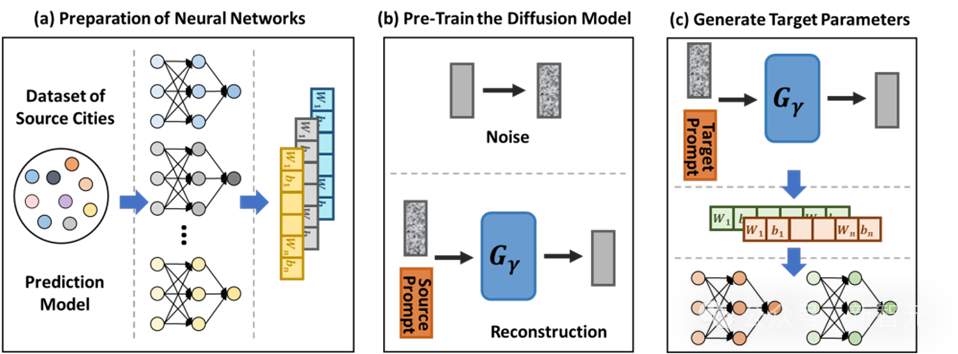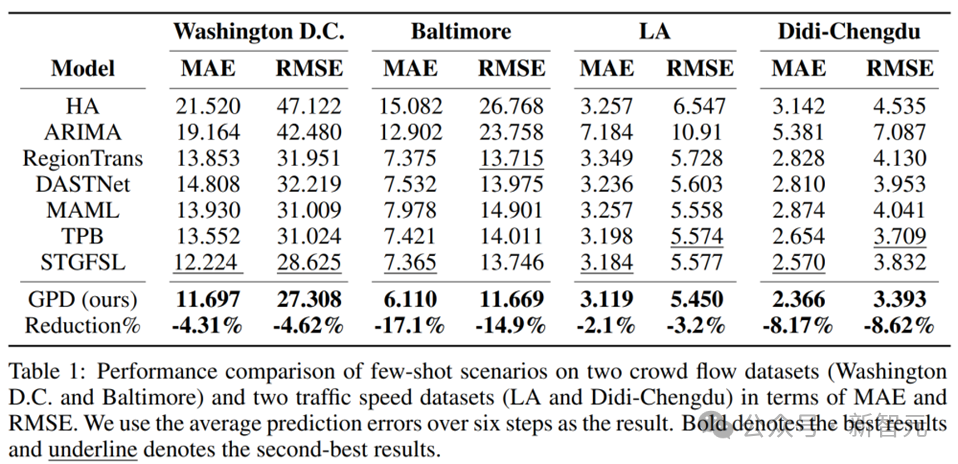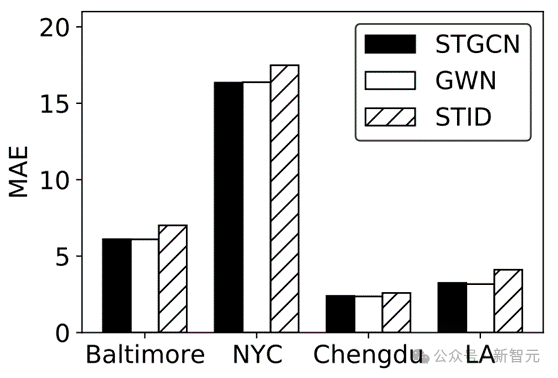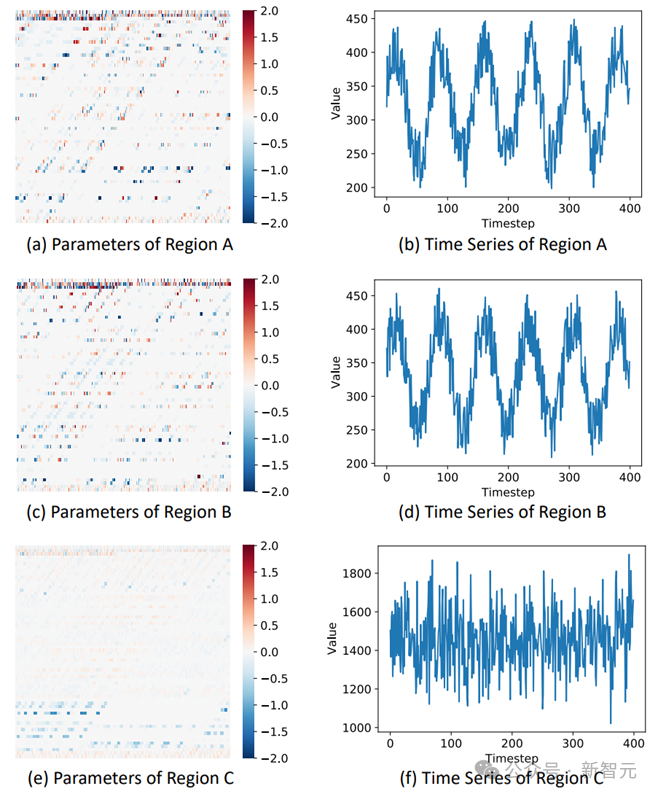 Technology peripherals
Technology peripherals
 AI
AI
 A clever solution to the 'data scarcity” problem! Tsinghua open source GPD: using diffusion model to generate neural network parameters
A clever solution to the 'data scarcity” problem! Tsinghua open source GPD: using diffusion model to generate neural network parameters
A clever solution to the 'data scarcity” problem! Tsinghua open source GPD: using diffusion model to generate neural network parameters
Traditional spatiotemporal prediction models usually require a large amount of data support to achieve good results.
However, spatiotemporal data (such as traffic and crowd flow data) in many regions are limited due to differences in development levels of different cities and inconsistencies in data collection policies. Therefore, model transferability becomes particularly important when data is scarce.
Current research mainly relies on data from source cities to train models and apply them to data from target cities, but this approach often requires complex matching designs. How to achieve broader knowledge transfer between source and target cities remains a challenging issue.
Recently, pre-trained models have made significant progress in the fields of natural language processing and computer vision. The introduction of prompt technology narrows the gap between fine-tuning and pre-training, allowing advanced pre-trained models to adapt to new tasks more quickly. The advantage of this method is that it reduces reliance on tedious fine-tuning and improves the efficiency and flexibility of the model. Through prompt technology, models can better understand user needs and produce more accurate output, thereby providing people with better experiences and services. This innovative approach is driving the development of artificial intelligence technology, bringing more possibilities and opportunities to various industries.
 Pictures
Pictures
Paper link: https://openreview.net/forum?id=QyFm3D3Tzi
Open source code and data: https ://www.php.cn/link/6644cb08d30b2ca55c284344a9750c2e
The latest achievement "Spatio-Temporal Few-Shot Learning via Diffusive Neural Network Generation" published at ICLR2024 by the Urban Science and Computing Research Center of the Department of Electronic Engineering of Tsinghua University The GPD (Generative Pre-Trained Diffusion) model was introduced to successfully achieve spatio-temporal learning in data sparse scenarios.
This method uses the parameters of the generative neural network to transform spatiotemporal sparse data learning into a generative pre-training problem for the diffusion model. Unlike traditional methods, this method no longer requires extracting transferable features or designing complex pattern matching strategies, nor does it need to learn a good model initialization for few-shot scenarios.
Instead, this method learns knowledge about neural network parameter optimization by pre-training on data from the source city, and then generates a neural network model suitable for the target city based on prompts.
The innovation of this method is that it can generate customized neural networks based on "prompts", effectively adapt to the differences in data distribution and characteristics between different cities, and achieve ingenious spatio-temporal knowledge transfer.
This research provides new ideas for solving the problem of data scarcity in urban computing. The paper's data and code are open source.
From data distribution to neural network parameter distribution
 Figure 1: Data pattern level knowledge transfer vs. neural network level knowledge transfer
Figure 1: Data pattern level knowledge transfer vs. neural network level knowledge transfer
As shown in Figure 1(a), traditional knowledge transfer methods usually train the model on the data of the source city and then apply it to the target city. However, there may be significant differences in data distribution between different cities, which results in direct migration of the source city model that may not fit well with the data distribution of the target city.
Therefore, we need to get rid of our reliance on messy data distribution and seek a more essential and transferable way of sharing knowledge. Compared with data distribution, the distribution of neural network parameters has more "high-order" characteristics.
Figure 1 shows the transformation process from the data pattern level to the neural network level knowledge transfer. By training a neural network on data from a source city and converting it into a process of generating neural network parameters adapted to the target city, the data distribution and characteristics of the target city can be better adapted.
Pre-training prompt fine-tuning: achieving spatio-temporal few-shot learning
 Figure 2 Overview of the GPD model
Figure 2 Overview of the GPD model
As shown in Figure 2, this study The proposed GPD is a conditional generation framework designed to learn directly from the model parameters of the source city and generate new model parameters for the target city. The method consists of three key stages:
1. Neural Network Preparatory phase: First, for each source city area, the study trains a separate spatiotemporal prediction model and saves its optimized network parameters. Model parameters for each region are optimized independently without parameter sharing to ensure that the model can best adapt to the characteristics of the respective region.
2. Diffusion model pre-training: This framework uses the collected pre-trained model parameters as training data to train the diffusion model to learn the process of generating model parameters. The diffusion model generates parameters through stepwise denoising, a process similar to the parameter optimization process starting from random initialization, and is therefore better able to adapt to the data distribution of the target city.
3. Neural network parameter generation: After pre-training, parameters can be generated by using regional cues of the target city. This approach leverages hints to facilitate knowledge transfer and precise parameter matching, taking full advantage of the similarities between inter-city regions.
It is worth noting that in the pre-training-cue fine-tuning framework, the selection of cues is highly flexible, as long as it can capture the characteristics of a specific area. For example, various static features such as population, regional area, functions, and distribution of points of interest (POIs) can be used to achieve this purpose.
This work utilizes regional cues from both spatial and temporal aspects: spatial cues come from node representations in urban knowledge graphs [1,2]. It only uses relationships such as regional adjacency and functional similarity. These Relations are readily available in all cities; temporal cues come from the encoder of a self-supervised learning model. See the original article for more details on prompt design.
In addition, this study also explored different cue introduction methods, and the experiment verified that the cue introduction based on prior knowledge has the optimal performance: using spatial cues to guide the generation of neural network parameters for modeling spatial correlation, and using time Prompt guides temporal neural network parameter generation.
Experimental results
The team described the experimental settings in detail in the paper to help other researchers reproduce their results. They also provided the original paper and open source data code, whose experimental results we focus on here.
To evaluate the effectiveness of the proposed framework, this study conducted experiments on two classic spatiotemporal prediction tasks: crowd flow prediction and traffic speed prediction, covering multiple city data sets.
 Picture
Picture
Table 1 shows the comparison results against state-of-the-art baseline methods on four datasets. Based on these results, the following observations can be made:
1) GPD exhibits significant performance advantages over the baseline model and consistently outperforms in different data scenarios, indicating that GPD achieves an effective neural network parameter level knowledge transfer.
2) GPD performs well in long-term prediction scenarios. This significant trend can be attributed to the framework’s mining of more essential knowledge, which helps transfer long-term spatiotemporal pattern knowledge to target cities.
 Figure 3 Performance comparison of different spatio-temporal prediction models
Figure 3 Performance comparison of different spatio-temporal prediction models
In addition, this study also verified the flexibility of the GPD framework for adapting to different spatio-temporal prediction models. In addition to the classic spatiotemporal graph method STGCN, this study also introduces GWN and STID as spatiotemporal prediction models and uses a diffusion model to generate their network parameters.
Experimental results show that the superiority of the framework will not be affected by model selection, so it can be adapted to various advanced models.
Further, this study conducts case analysis by manipulating pattern similarity on two synthetic datasets.
Figure 4 shows that regions A and B have highly similar time series patterns, while region C exhibits significantly different patterns. Meanwhile, Figure 5 shows that nodes A and B have symmetric spatial positions.
Therefore, we can infer that regions A and B have very similar spatiotemporal patterns, while there are obvious differences from C. The neural network parameter distribution results generated by the model show that the parameter distributions of A and B are similar, but significantly different from the parameter distribution of C. This further validates the ability of the GPD framework to effectively generate neural network parameters with diverse spatiotemporal patterns.

Figure 4 Visualization of time series and neural network parameter distribution in different regions

Figure 5 Simulation data set regional space Connection relationship
Reference:
https://www.php.cn/link/6644cb08d30b2ca55c284344a9750c2e
[1] Liu, Yu, et al. "Urbankg: An urban knowledge graph system." ACM Transactions on Intelligent Systems and Technology 14.4 (2023): 1-25.
[2] Zhou, Zhilun, et al. "Hierarchical knowledge graph learning enabled socioeconomic indicator prediction in location-based social network." Proceedings of the ACM Web Conference 2023. 2023.
The above is the detailed content of A clever solution to the 'data scarcity” problem! Tsinghua open source GPD: using diffusion model to generate neural network parameters. For more information, please follow other related articles on the PHP Chinese website!

Hot AI Tools

Undresser.AI Undress
AI-powered app for creating realistic nude photos

AI Clothes Remover
Online AI tool for removing clothes from photos.

Undress AI Tool
Undress images for free

Clothoff.io
AI clothes remover

AI Hentai Generator
Generate AI Hentai for free.

Hot Article

Hot Tools

Notepad++7.3.1
Easy-to-use and free code editor

SublimeText3 Chinese version
Chinese version, very easy to use

Zend Studio 13.0.1
Powerful PHP integrated development environment

Dreamweaver CS6
Visual web development tools

SublimeText3 Mac version
God-level code editing software (SublimeText3)

Hot Topics
 The world's most powerful open source MoE model is here, with Chinese capabilities comparable to GPT-4, and the price is only nearly one percent of GPT-4-Turbo
May 07, 2024 pm 04:13 PM
The world's most powerful open source MoE model is here, with Chinese capabilities comparable to GPT-4, and the price is only nearly one percent of GPT-4-Turbo
May 07, 2024 pm 04:13 PM
Imagine an artificial intelligence model that not only has the ability to surpass traditional computing, but also achieves more efficient performance at a lower cost. This is not science fiction, DeepSeek-V2[1], the world’s most powerful open source MoE model is here. DeepSeek-V2 is a powerful mixture of experts (MoE) language model with the characteristics of economical training and efficient inference. It consists of 236B parameters, 21B of which are used to activate each marker. Compared with DeepSeek67B, DeepSeek-V2 has stronger performance, while saving 42.5% of training costs, reducing KV cache by 93.3%, and increasing the maximum generation throughput to 5.76 times. DeepSeek is a company exploring general artificial intelligence
 KAN, which replaces MLP, has been extended to convolution by open source projects
Jun 01, 2024 pm 10:03 PM
KAN, which replaces MLP, has been extended to convolution by open source projects
Jun 01, 2024 pm 10:03 PM
Earlier this month, researchers from MIT and other institutions proposed a very promising alternative to MLP - KAN. KAN outperforms MLP in terms of accuracy and interpretability. And it can outperform MLP running with a larger number of parameters with a very small number of parameters. For example, the authors stated that they used KAN to reproduce DeepMind's results with a smaller network and a higher degree of automation. Specifically, DeepMind's MLP has about 300,000 parameters, while KAN only has about 200 parameters. KAN has a strong mathematical foundation like MLP. MLP is based on the universal approximation theorem, while KAN is based on the Kolmogorov-Arnold representation theorem. As shown in the figure below, KAN has
 Hello, electric Atlas! Boston Dynamics robot comes back to life, 180-degree weird moves scare Musk
Apr 18, 2024 pm 07:58 PM
Hello, electric Atlas! Boston Dynamics robot comes back to life, 180-degree weird moves scare Musk
Apr 18, 2024 pm 07:58 PM
Boston Dynamics Atlas officially enters the era of electric robots! Yesterday, the hydraulic Atlas just "tearfully" withdrew from the stage of history. Today, Boston Dynamics announced that the electric Atlas is on the job. It seems that in the field of commercial humanoid robots, Boston Dynamics is determined to compete with Tesla. After the new video was released, it had already been viewed by more than one million people in just ten hours. The old people leave and new roles appear. This is a historical necessity. There is no doubt that this year is the explosive year of humanoid robots. Netizens commented: The advancement of robots has made this year's opening ceremony look like a human, and the degree of freedom is far greater than that of humans. But is this really not a horror movie? At the beginning of the video, Atlas is lying calmly on the ground, seemingly on his back. What follows is jaw-dropping
 AI subverts mathematical research! Fields Medal winner and Chinese-American mathematician led 11 top-ranked papers | Liked by Terence Tao
Apr 09, 2024 am 11:52 AM
AI subverts mathematical research! Fields Medal winner and Chinese-American mathematician led 11 top-ranked papers | Liked by Terence Tao
Apr 09, 2024 am 11:52 AM
AI is indeed changing mathematics. Recently, Tao Zhexuan, who has been paying close attention to this issue, forwarded the latest issue of "Bulletin of the American Mathematical Society" (Bulletin of the American Mathematical Society). Focusing on the topic "Will machines change mathematics?", many mathematicians expressed their opinions. The whole process was full of sparks, hardcore and exciting. The author has a strong lineup, including Fields Medal winner Akshay Venkatesh, Chinese mathematician Zheng Lejun, NYU computer scientist Ernest Davis and many other well-known scholars in the industry. The world of AI has changed dramatically. You know, many of these articles were submitted a year ago.
 Google is ecstatic: JAX performance surpasses Pytorch and TensorFlow! It may become the fastest choice for GPU inference training
Apr 01, 2024 pm 07:46 PM
Google is ecstatic: JAX performance surpasses Pytorch and TensorFlow! It may become the fastest choice for GPU inference training
Apr 01, 2024 pm 07:46 PM
The performance of JAX, promoted by Google, has surpassed that of Pytorch and TensorFlow in recent benchmark tests, ranking first in 7 indicators. And the test was not done on the TPU with the best JAX performance. Although among developers, Pytorch is still more popular than Tensorflow. But in the future, perhaps more large models will be trained and run based on the JAX platform. Models Recently, the Keras team benchmarked three backends (TensorFlow, JAX, PyTorch) with the native PyTorch implementation and Keras2 with TensorFlow. First, they select a set of mainstream
 Tesla robots work in factories, Musk: The degree of freedom of hands will reach 22 this year!
May 06, 2024 pm 04:13 PM
Tesla robots work in factories, Musk: The degree of freedom of hands will reach 22 this year!
May 06, 2024 pm 04:13 PM
The latest video of Tesla's robot Optimus is released, and it can already work in the factory. At normal speed, it sorts batteries (Tesla's 4680 batteries) like this: The official also released what it looks like at 20x speed - on a small "workstation", picking and picking and picking: This time it is released One of the highlights of the video is that Optimus completes this work in the factory, completely autonomously, without human intervention throughout the process. And from the perspective of Optimus, it can also pick up and place the crooked battery, focusing on automatic error correction: Regarding Optimus's hand, NVIDIA scientist Jim Fan gave a high evaluation: Optimus's hand is the world's five-fingered robot. One of the most dexterous. Its hands are not only tactile
 FisheyeDetNet: the first target detection algorithm based on fisheye camera
Apr 26, 2024 am 11:37 AM
FisheyeDetNet: the first target detection algorithm based on fisheye camera
Apr 26, 2024 am 11:37 AM
Target detection is a relatively mature problem in autonomous driving systems, among which pedestrian detection is one of the earliest algorithms to be deployed. Very comprehensive research has been carried out in most papers. However, distance perception using fisheye cameras for surround view is relatively less studied. Due to large radial distortion, standard bounding box representation is difficult to implement in fisheye cameras. To alleviate the above description, we explore extended bounding box, ellipse, and general polygon designs into polar/angular representations and define an instance segmentation mIOU metric to analyze these representations. The proposed model fisheyeDetNet with polygonal shape outperforms other models and simultaneously achieves 49.5% mAP on the Valeo fisheye camera dataset for autonomous driving
 Single card running Llama 70B is faster than dual card, Microsoft forced FP6 into A100 | Open source
Apr 29, 2024 pm 04:55 PM
Single card running Llama 70B is faster than dual card, Microsoft forced FP6 into A100 | Open source
Apr 29, 2024 pm 04:55 PM
FP8 and lower floating point quantification precision are no longer the "patent" of H100! Lao Huang wanted everyone to use INT8/INT4, and the Microsoft DeepSpeed team started running FP6 on A100 without official support from NVIDIA. Test results show that the new method TC-FPx's FP6 quantization on A100 is close to or occasionally faster than INT4, and has higher accuracy than the latter. On top of this, there is also end-to-end large model support, which has been open sourced and integrated into deep learning inference frameworks such as DeepSpeed. This result also has an immediate effect on accelerating large models - under this framework, using a single card to run Llama, the throughput is 2.65 times higher than that of dual cards. one





